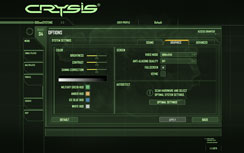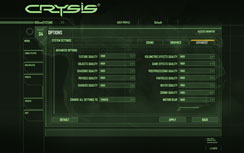Crysis
Publisher: Electronic ArtsWhat can we say about this game that hasn’t been said already? Crysis is probably the most anticipated game on the PC last year and was released on November 16th 2007.
Crysis is seen by many as the poster boy for DirectX 10 and it will make your system cry, quite literally – it’s a monster! It doesn’t come as much of a surprise then, that the graphics are something special – they’re above and beyond anything we’ve ever seen in a PC game.
We tested the game using the 64-bit executable under both DirectX 9.0 and DirectX 10 with the 1.2 patch applied. We used a custom timedemo recorded on the Harbor map which is more representative of gameplay than the built-in benchmark that renders things much faster than you're going to experience in game. We found that around 30-33 fps in our timedemo was sufficient enough to obtain a playable frame rate through the game. It's a little different to other games in that the low frame rates still appear to be quite smooth.
For our testing, we set Texture Detail, Shadows Quality, Physics Quality, Shaders Quality and Water Quality to High, while all other settings were set to medium. Because of how intense the game is, we tested with both anti-aliasing and anisotropic filtering disabled at resolutions above 1280x1024 for the time being. There is currently no support for anisotropic filtering in the game, but you can still force it from the driver control panel.
DirectX 10
DirectX 9.0
In situations where SLI and CrossFire scaling isn’t as good as it can be in Crysis, the BFG Tech GeForce 9800 GTX OCX outperforms the Radeon HD 3870 X2 and almost matches the GeForce 9800 GX2’s raw baseline performance. That’s obviously nothing to sniff at, but things do change when you increase the resolution to 1,920 x 1,200 – the Radeon HD 3870 X2 is all of a sudden a faster card, delivering higher frame rates and an overall smoother gameplay experience. It’s not all plain sailing for the X2 though, as its minimum frame rate is pretty low, meaning there are times where there is some apparent stuttering when explosions go off.
The only scenario where we saw enough of a performance difference between the standard 9800 GTX and BFG Tech’s heavily overclocked version for it to be noticeable in real-world gameplay scenarios was at 1,920 x 1,200—and only under DirectX 10 mode where the frame rates are on the ragged edge of playability. You’ll be able to get a passable gameplay experience on the BFG Tech card, but you’re going to have to lower a few settings to get a similar experience on the standard clocked card.

MSI MPG Velox 100R Chassis Review
October 14 2021 | 15:04











Want to comment? Please log in.